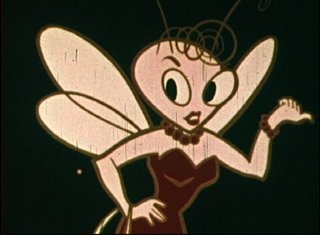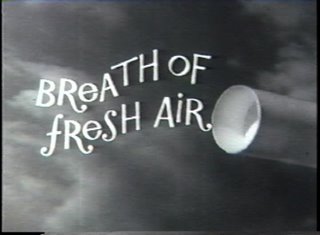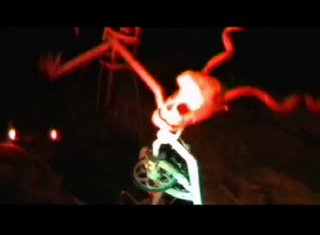Reviews of film ephemera, including such things as educational films, industrial films, military and propaganda films, tv commercials, movie trailers, shorts, experimental films, and movies made for non-mainstream audiences.
Dr. Jekyll and Mr. Hyde (1913) (Sinister Cinema). [Category: Early Film & TV]
It's only two years later, but this adaptation is much longer than the 1911 version, with much more complex storytelling and lots more exposition. Lots more stuff happens, too. The Mr. Hyde makeup, though, is not nearly as good as in the 1911 version, and, I dunno, the film is just not as much fun as the earlier one (though there are some scenes with Mr. Hyde and Jekyll's servants that are priceless). A 1913 IMP film. Sinister Cinema gets a few extra points for throwing some extras onto the tape.Ratings: Camp/Humor Value: ***. Weirdness: **. Historical Interest: ***. Overall Rating: ***.

Among Your Souvenirs (film #1 on AV Geeks). [Category: Public Service]
This 60s film warns travelers of the dangers of accidentally bringing back foreign insect pests and plant diseases in the souvenirs they buy, and explains why customs officials have to inspect your luggage and confiscate certain items. Although the danger is real, there is a real paranoid feel to this film in its fears of foreign contamination, making the film rather mstable. Fun to see are the many tacky souvenirs pictured and Pestina, the slutty cartoon character meant to represent foreign insect pests. Mostly, this is pretty ordinary, but it has its moments.Ratings: Camp/Humor Value: ***. Weirdness: ***. Historical Interest: ****. Overall Rating: ***.

Airwaves (film #882 on Open Source Movies). [Category: Outtakes & Obscurities]
Computer animation brings us undersea stalagmites and bubble-like forms, while techno music plays in the background. Fairly mesmerizing.Ratings: Camp/Humor Value: *. Weirdness: ***. Historical Interest: ***. Overall Rating: ***.
Duck and Cover (film #1 on Atomic Beach Blast Bingo DVD (A/V Geeks).Also, film #1 on Atomic Memories (Video Yesteryear). Also, film #2 on Atomic Scare Films, Vol. 1 (Something Weird, 1996). Also, film #1 on Atomic TV (Video Resources, 1994). Also, extra on Atomic War Bride/This Is Not a Test DVD (Something Weird, 2002). Also, film #5 on The Educational Archives, Vol. 5: Patriotism DVD (Fantoma, 2003). Also in the Ephemeral section of Open Video Project. Also, film #466 on Prelinger Archive. Also, film #1 on U.S. Government Classics (Worldwide Entertainment Marketing, 1991)). [Category: Military & Propaganda]
This children's educational film is probably the most memorable piece of Cold War ephemera. Animated Bert the Turtle tells kids they always have to be aware that the atomic bomb could go off any minute, but if they duck down and cover the backs of their necks, they'll be O.K. Apparently, this was widely shown in elementary schools during the 50s, and one wonders the effect it had on the mental health of the schoolchildren of the era. A must.Ratings: Camp/Humor Value: *****. Weirdness: ****. Historical Interest: *****. Overall Rating: *****.
Drew Pearson Reports on Science in Israel (film #15 in the General section of the State of Israel section of Stephen Spielberg Jewish Film Archive). [Category: News]
Reporter Drew Pearson tells us all about scientific research in Israel in this 50s film, covering such things as medical research, nuclear energy, fly control, and early experiments into solar energy. Many of Israel’s leading scientists of the time are interviewed. If you want to know about the state of scientific research in Israel in the 50s, then this is your film. The variety of different kinds of research presented keeps the film fairly interesting to the average viewer as well.Ratings: Camp/Humor Value: *. Weirdness: ***. Historical Interest: ****. Overall Rating: ***.
The Ballad of Kiriat Shmoneh (film #11 in the Cities section of the State of Israel section of Stephen Spielberg Jewish Film Archive). [Category: Military & Propaganda]
This 70s film tells the story of terrorist attacks on the Israeli city of Kiriat Shmoneh, a city on the border with Lebanon. Mostly, this is the story of how the people survived the trauma of the massacre-like attacks, which involved Arab terrorists going door to door and killing everybody they found. They let the people tell their own stories in this, which makes for a powerful film that has impact without a hint of melodrama. A compelling portrait of how terrorism affects the lives of ordinary people.Ratings: Camp/Humor Value: N/A. Weirdness: ***. Historical Interest: *****. Overall Rating: ****.

Explosives: Tool for Progress (film #5 on AV Geeks). [Category: Industrial]
This 70s film asserts that we owe everything good in our modern society entirely––not to railroads, not to aluminum, not to crop spraying, not even to truck farmers––but to blowing things up, a sentiment every boy will agree with. Unfortunately, they don’t really get around to blowing things up real good until the end of the film. Until then, we get lots of scenes of construction projects in Manhattan, the Grand Coulee Dam, and the Panama Canal, with a scene of a very 70s housewife and her little girl baking a pie in a very 70s kitchen thrown in for good measure. Consequently, the film is not quite as much fun as it sounds––by the end of the film, all fans of explosions will be chanting “Blast ‘em! Blast ‘em! Blast ‘em!” over and over again. For real explosion fun, I say stick with the atomic bomb films of the 50s.Ratings: Camp/Humor Value: ***. Weirdness: ***. Historical Interest: ****. Overall Rating: ***.
Fright to the Finish (film #3 on Cartoon Explosion, Vol. 2: Foney Fables/Popeye's Greatest Hits DVD (Front Row Entertainment, 2002). Also, film #17 on Cartoon Mania DVD (Front Row Entertainment, 2002). Also, extra on Drive-In Discs, Vol. 2 DVD (Elite Entertainment, 2001). Also, film #132 on Feature Films. Also, film #41 on 50 Cartoon Classics DVD. Also, film #19 on Film Chest Vintage Cartoons. Also, film #6 on Disc #1 of 100 Cartoon Classics DVD Megapack (Treeline Films, 2004). Also, film #6 on Disc #4 of 150 Cartoon Classics DVD Megapack (Mill Creek Entertainment, 2006)). [Category: Hollywood]
On Halloween night, Popeye and Bluto take turns scaring Olive Oyl to death, while making her believe it's the other one doing it. This has some funny gags, including "vanishing cream" that does just what you expect it to do in a cartoon, but mostly it's pretty ordinary.Ratings: Camp/Humor Value: ***. Weirdness: **. Historical Interest: ***. Overall Rating: ***.
Assignment Tel Aviv (film #11 in the Pre-State section of Stephen Spielberg Jewish Film Archive). [Category: Hollywood]
Bright, breezy film from the 40s about Tel Aviv and what a modern city it is. A reporter stays with a Jewish family and gives a glowing report of life in the city, likening it to the American way of life, and making it seem much better than life in a nearby Arab-controlled city. This was made right before Israel won its independence, so there is definitely some political motivation to this travelogue, though in other ways, it’s no different than many other city profile films made at the time. I like the section on locally-produced groceries for its scenes of the colorful labels on canned and packaged goods.Ratings: Camp/Humor Value: **. Weirdness: **. Historical Interest: ****. Overall Rating: ***.
BBC1 Schools Interval from 1975 (film #9 in the Schools section of TVArk). [Category: Educational]
A still title card announces that the next show will be starting soon, while Dixieland jazz plays in the background. This is a realistic example of what educational television stations broadcast between programs at the time, but it’s not very interesting to watch.Ratings: Camp/Humor Value: *. Weirdness: **. Historical Interest: ***. Overall Rating: **.
A Communications Primer (film #360 on Prelinger Archive). [Category: Educational]
This film was made by Charles and Ray Eames, which makes it more intelligent and visually striking than most educational films. It deals with the semantics of communication, breaking down the concept into a flow chart of choosing, coding, sending, receiving, decoding, and understanding messages. This is applied to modes of communication as simple as “one if by land and two if by sea” and as complex as billions of neurons firing in the human nervous system. Visually, these concepts are portrayed with a collage of animation, film clips, photographs, electronically-generated images, and images from famous works of art. Aurally, they are portrayed with deadpan narration and a haunting music score by Elmer Bernstein. This film is to films like Communications and Our Town, as 2nd-grade social studies is to a graduate-level course in philosophy. But at heart, it’s still an educational film, so it still qualifies as ephemera, though smarter than your average piece of ephemera. The Eames were key players in the modernist design movement, giving this film a great deal of historical value.Ratings: Camp/Humor Value: *. Weirdness: ****. Historical Interest: *****. Overall Rating: ****.
Burns & Allen Show #3 (film #3 on Side A of Disc #4 of TV Favorites DVD Megapack (Treeline Films, 2003)). [Category: Early Film & TV]
More silliness with George Burns and Gracie Allen. This one has the fluffiest of plots involving Harry Morton’s secretary making Blanche jealous, until she finds out he’s a man. Mostly, though, this is gags aplenty, Gracie’s illogical logic, and Bill Goodwin’s bizarre Carnation commercials that are woven into the action. There’s a real vaudeville and radio feel to this one, making it a good example of early TV.Ratings: Camp/Humor Value: ****. Weirdness: *****. Historical Interest: *****. Overall Rating: ****.

Belair Commercials Compilation #1 (film #159 on UCSF Tobacco Control Archive). [Category: Commercial]
Collection of dorky early-60s commercials for Belair cigarettes, mostly featuring groups of very white people partying by singing Belair jingles, which is at least livelier than the last 3, which feature a white guy talking to the camera. These are not as fun as some of the Raleigh commercials, but they do have the appealing dorkiness from the days before advertisers discovered the concept of cool.Ratings: Camp/Humor Value: ****. Weirdness: ***. Historical Interest: ****. Overall Rating: ****.
Campus in Jerusalem (film #8 in the Hebrew University of Jerusalem section of Stephen Spielberg Jewish Film Archive). [Category: Sleaze & Outsider]
In this 1960 film, students study at the Hebrew University of Jerusalem while the school’s new campus is being built around them. Various research projects are highlighted in such areas as biology, medicine, law and sociology. This is a straightforward film that has historical value in showing the development of the Hebrew University.Ratings: Camp/Humor Value: *. Weirdness: *. Historical Interest: ****. Overall Rating: ***.
Hands of Healing (film #5 in the Health section of the State of Israel section of Stephen Spielberg Jewish Film Archive). [Category: Public Service]
An American doctor tells us how vastly impressed he is by the good works being done by the Hadassah Medical Center in Israel, especially in helping new immigrants. And boy, is he impressed. Still, he has a lot to be impressed with, so the film just barely escapes being hyperbolic, and lands in the typical good-works film category, perhaps made livelier by the emotional narration. Like many of these Hadassah films, this has historical value in documenting healthcare in Israel during the 50s.Ratings: Camp/Humor Value: ***. Weirdness: ***. Historical Interest: ****. Overall Rating: ***.
Dr. Jekyll and Mr. Hyde (track #1 on Dr. Jeckyll and Mr. Hyde (Barrymore) (Sinister Cinema, 1999)). [Category: Early Film & TV]
This 1911 adaptation of the well-known Robert Louis Stevenson story is quite lively and fun, with good performances and great Mr. Hyde makeup. The Jekyll-Hyde transformation is done with a simple jump-cut (no long, drawn-out transformation here), but Mr. Hyde is so lively and so different from the dapper Dr. Jekyll that you hardly care. A surprisingly good adaptation for its time. A 1911 Thanhouser film.Ratings: Camp/Humor Value: ****. Weirdness: ***. Historical Interest: ****. Overall Rating: ****.

Ahoy! Have Any of You Lot Seen Sinbad? (film #302 on Open Source Movies). [Category: Outtakes & Obscurities]
Robots with junk bodies and human skull heads dance a robot twist to Elvis’ “Hound Dog”. Proving that even robots dig rock ‘n’ roll. I love robots so I enjoyed this.Ratings: Camp/Humor Value: **. Weirdness: ****. Historical Interest: ***. Overall Rating: ***.
Drew Pearson Reporting on Religion in Israel (film #14 in the General section of the State of Israel section of Stephen Spielberg Jewish Film Archive). [Category: News]
This 50s film features reporter Drew Pearson reporting on religious freedom in Israel. The portrait is quite rosy and optimistic, with Jews, Muslims, and Christians peacefully practicing their faiths together. However, the shadow of potential violence occasionally peeks into the proceedings. This is a historically interesting film that gives us a snapshot of religious practices in Israel during the 50s. It’s too bad such peace and tolerance could not be maintained over the long run.Ratings: Camp/Humor Value: *. Weirdness: **. Historical Interest: ****. Overall Rating: ***.

Baghdad Pact: Unified Military Command Foreseen (film #82 on Universal Newsreels). [Category: Military & Propaganda]
50s newsreel story about peace talks in the Middle East that were rudely preceded by a bombing at the American embassy. Also included is a story about a large camera designed to track missiles. This is straightforward and unsurprising.Ratings: Camp/Humor Value: *. Weirdness: *. Historical Interest: ***. Overall Rating: **.
Subscribe to:
Posts (Atom)
Better Reading
Better Reading . Teenager Harold Wilson has a problem—he can’t read for (expletive deleted). So he has to spend all his free time studying ...

-
The Best Made Plans. A 50s housewife solves all problems with Saran Wrap plastic film. Of course, all her problems are the kinds we all wa...
-
Annie Oakley – Annie and the First Phone (film #15 in the Classic TV section of Movieflix ). [Category: Early Film & TV] This early-50s ...
-
Buffalo Bill, Jr. – A Bronc Called Gunboat (film #4 on Disc #2 of Classic Kids’ Shows DVD (Genius Entertainment, 2004)). [Category: Early F...